How Liquidity Recollateralization Tokens Revolutionize DeFi
Since the beginning of 2024, the total value locked in liquid re-staking tokens has risen by more than 8,300%.
 JinseFinance
JinseFinance
Author: DeSpread Research
Decentralized Finance (DeFi) is a new form of finance that aims to enable trustless transactions without intermediaries through blockchain and smart contracts, increase access to financial services in areas lacking financial infrastructure, and disrupt the traditional financial system by improving transparency and efficiency. The origin of DeFi can be traced back to Bitcoin developed by Satoshi Nakamoto.
During the global financial crisis in 2008, Satoshi Nakamoto was disturbed by the news of bank failures and government rescues of banks. He believed that over-reliance on trusted institutions, opacity, and inefficiency were the fundamental problems of the centralized financial system. To solve this problem, Satoshi Nakamoto developed Bitcoin to provide a system for value transfer and payment in a decentralized environment. Satoshi Nakamoto added the message "The Times, January 3, 2009, UK Chancellor of the Exchequer on brink of second bailout for banks" to the genesis block of Bitcoin, indicating the problems that Bitcoin is going to solve and the need for decentralized finance.
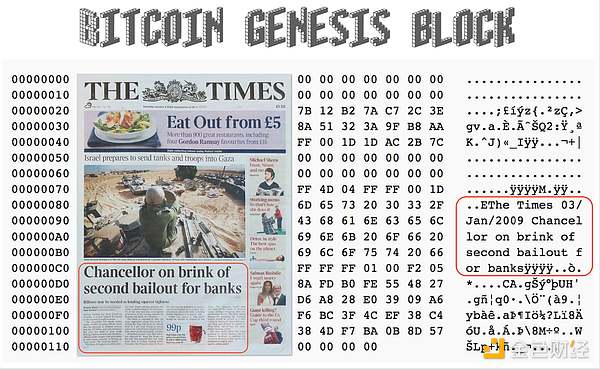
Bitcoin Genesis Block and London Times front page, source:
phuzion7 steemit
Since then, the emergence of Ethereum in 2015 and the introduction of smart contracts have spawned a series of DeFi protocols. Until now, these protocols have been able to provide financial services such as token swaps and loans without intermediaries, and have been continuously conducting large-scale trials and research around the concept of "decentralized finance" proposed by Satoshi Nakamoto. These protocols have formed a huge ecosystem through the ability to combine and connect with each other similar to "MoneyLego", and have realized a wide range of financial transactions that Bitcoin cannot provide in a decentralized form, opening up the possibility of replacing the role of trusted institutions in the traditional financial system with blockchain.
However, so far, most of the rapidly growing liquidity in the DeFi market still comes from the yields provided by various protocols to liquidity providers, rather than from decentralization or financial system innovation. In particular, these protocols, with their own token economy, have brought users various incentives beyond traditional finance through the so-called "yield farming", which has effectively attracted many users and played a big role in bringing liquidity into the DeFi market.
As users pay more and more attention to higher yields, the revenue model of DeFi protocols has been evolving from its initial design, from an initial revenue model designed with the core value of "providing financial services without intermediaries" to a market demand that can "continue to provide users with stable and high returns." Recently, there have even been some protocols that borrow centralized elements, distributing the generated income to users by using real-world assets as collateral or executing transactions through centralized exchanges.
In this article, we will explore the various mechanisms and evolution of DeFi, and have an in-depth understanding of the challenges faced by these DeFi protocols to the process of partially adopting centralized elements. 2. Liquidity Mining and DeFi Summer Early DeFi protocols that emerged on the Ethereum network focused on implementing the traditional financial system on the blockchain. Therefore, in addition to using blockchain to change the trading environment, removing service providers in the process and allowing anyone to become a liquidity provider, early DeFi protocols are no different from traditional finance in terms of revenue generation and structure. Decentralized Exchanges (DEX): Like currency exchanges and stock exchanges, revenue is generated through transaction fees. Users collect a certain percentage of each token transaction and distribute this fee to liquidity providers.
Subsequently, in June 2020, the most representative lending agreement Compound launched the Liquidity Mining activity to attract liquidity in the market before and after the Bitcoin halving, and by issuing the governance token $COMP and distributing it to liquidity providers and borrowers, it caused a large amount of liquidity and lending demand on Compound. Compound TVL changes, source: Defi Llama Under Compound’s initiative, the DeFi protocol began to change from its original trend of simply distributing protocol revenue to liquidity providers. Other early DeFi protocols such as Aave and Uniswap Projects also began to issue their own tokens to pay rewards in addition to protocol revenue. Since then, the DeFi ecosystem has begun to welcome a large number of users and liquidity, bringing the "DeFi Summer" we all know to the entire Ethereum network.
Liquidity mining provides service providers and users with a strong incentive to use services, greatly improving the liquidity of DeFi protocols and expanding the user base. However, the additional income generated by liquidity mining in the early days had the following limitations.
The utility of issuing tokens is limited to governance, so there is a lack of buy-in factors.
These limitations make it difficult to maintain the liquidity and user traffic attracted by liquidity mining in the long term. Subsequent DeFi protocols have attempted to establish a token economic model that allows them to provide liquidity providers with additional benefits beyond protocol revenue, while also maintaining the liquidity of the introduced protocols in the long term. Many protocols link the value of their own tokens to the revenue of the protocol and provide continuous incentives to token holders, thereby improving the stability and sustainability of the protocol.
Curve Finance and Olympus DAO are two of the best examples in this regard.
Curve Finance is a DEX that provides low slippage transactions for stablecoins. Curve provides its own token $CRV and transaction fees taken from the liquidity pool as rewards for liquidity mining to liquidity providers. However, Curve Finance improves the sustainability of liquidity mining by introducing the "veTokenomics" system.
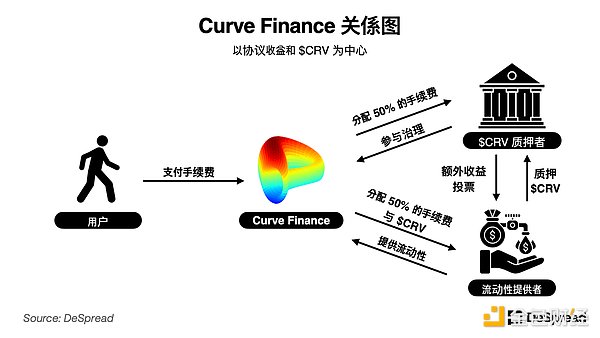
Detailed introduction to Vetokenomics
Liquidity providers only charge 50% of the transaction fees. They will not sell the $CRV obtained from liquidity mining to the market, but deposit it in Curve Finance according to the set period (up to 4 years) and obtain $veCRV.
Curve Finance allows liquidity providers to lock up their earned $CRV tokens for a long time, thereby reducing the pressure to sell. In addition, by introducing a voting function that allows specific liquidity pools to receive additional rewards, it increases the demand for projects that want to provide liquidity for Curve Finance to buy and hold $CRV in the market.
Under the influence of these effects, the lock-up ratio of $CRV tokens has grown rapidly, reaching 40% within a year and a half, and has remained so to this day.

$CRV lock rate trend, source:
@blockworks_research Dune Dashboard
This mechanism of Curve Finance is considered to be a good attempt, not only providing high returns to ensure liquidity in the short term, but also pursuing sustainability by closely integrating its tokens with the working mechanism of the protocol, becoming a source of inspiration for the token economic model of many subsequent DeFi protocols.
Olympus DAO is a protocol that aims to create on-chain reserve tokens. Olympus DAO receives liquidity deposits from users to establish and manage reserves, and issues its own protocol token $OHM in proportion to the reserves. In the process of issuing $OHM, Olympus DAO introduced a unique mechanism of "Bonds", which allows users to deposit LP tokens containing $OHM and issue bonds corresponding to $OHM.
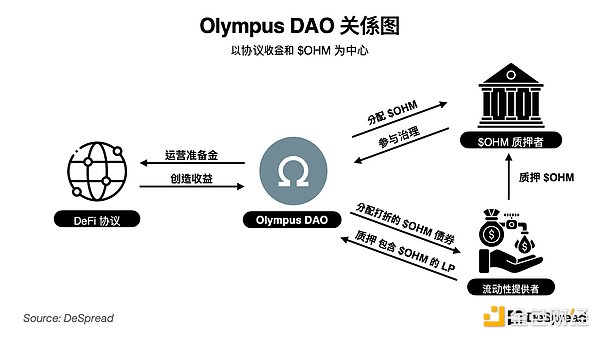
Token Economic Details
Users can deposit LP tokens consisting of a single asset (such as Ethereum, stablecoins, or OHM-asset pairs) and receive discounted OHM bonds in return, and Olympus DAO will manage these assets through governance to earn returns.
Through the above mechanism, Olympus DAO provides sufficient $OHM to the market, while also directly holding LP tokens with ownership of the liquidity pool to prevent traditional liquidity providers from easily withdrawing liquidity in pursuit of short-term gains. In the early days of the protocol, a large amount of liquidity poured in and reserves were increased. In the process of issuing more $OHM to pay holders, the annual yield (APY) exceeded 7,000% and lasted for about six months.
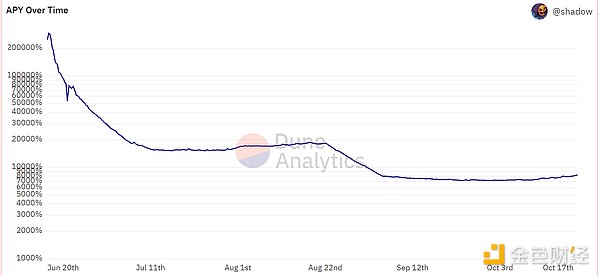
Olympus DAO staking APY, source: @shadow Dune Dashboard
These high annual interest rates encourage users to continue depositing assets into Olympus DAO's treasury to mint $OHM, triggering the launch of many DeFi protocols that adopt the Olympus DAO mechanism in 2021. 4. The DeFi Bear Market and the Rise of Real Yield The rise of DeFi protocols has caused the total TVL (total locked volume) of the DeFi market to reach an unprecedented high in November 2021. However, the market then entered a correction phase, and liquidity inflows gradually decreased, culminating in the collapse of the Terra-Luna ecosystem in May 2022, leading to a full-scale bear market. This reduced liquidity across the market, which not only suppressed investor sentiment, but also hit early and second-generation DeFi protocols such as Curve Finance and Olympus DAO.
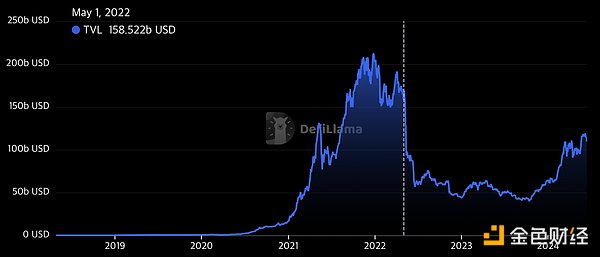
TVL trend of the overall DeFi protocol, source:
Defi Llama
While the token economic models adopted by these protocols have overcome the limitations of their own tokens’ lack of utility to a certain extent, there is still the problem that the value of their own tokens will affect the interest rates of liquidity providers, especially in an environment where the market environment is constantly changing and investment sentiment has dropped significantly, the income of these protocols has not been able to catch up with the speed of continued token inflation, showing the limitations of these protocols’ structure.
Therefore, the reduction in token value and protocol revenue has accelerated the outflow of assets deposited in the protocol, resulting in a vicious cycle that makes it difficult for the protocol to generate stable income and provide users with attractive interest rates. In this case, the "Real Yield" DeFi protocol that can significantly limit the inflation rate of its own tokens while generating revenue for the protocol in a sustainable manner has become a new focus.
One of the most famous real-yield DeFi protocols is the GMX Protocol, a decentralized perpetual contract exchange based on the Arbitrum and Avalanche networks.
The GMX Protocol has two tokens, $GLP and $GMX, and its operating mechanism is as follows.
Liquidity providers deposit $ETH, $BTC, $USDC, $USDT and other assets into GMX, and they can obtain $GLP tokens as proof of providing liquidity, and $GLP holders can obtain 70% of the income generated by the GMX protocol.
Instead of providing additional rewards through token inflation, the GMX protocol chooses to distribute part of the income generated by the protocol to its own token holders. This approach provides clear incentives for users to buy and hold $GMX, thereby ensuring that token holders will not sell tokens for profit, nor will the tokens face inflationary depreciation during market downturns.
If we actually observe the changes in the revenue of the GMX protocol and the price of the $GMX token, we will find that the value of the $GMX token will rise and fall with the revenue of the GMX protocol.
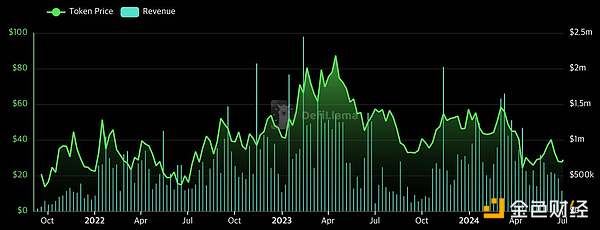
GMX protocol revenue and token price trend, source: Defi Llama
However, compared with traditional protocols, this structure allocates part of the fees that liquidity providers deserve to governance token holders, which is somewhat disadvantageous to liquidity providers and is not ideal for attracting initial liquidity. In addition, when distributing the governance token $GMX, the GMX protocol focused on promoting the GMX protocol to potential users by airdropping to DeFi users of Arbitrum and Avalanche, rather than using liquidity mining activities to quickly obtain liquidity.
Despite this, the GMX protocol is currently the protocol with the highest TVL among derivative DeFi protocols, and is also one of the few platforms that has maintained its TVL after the bear market after Luna-Terra.
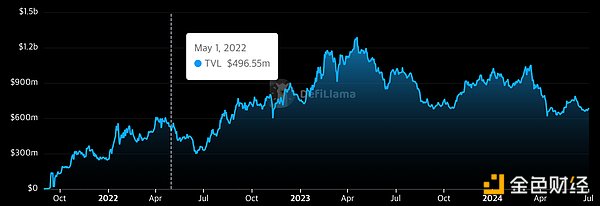
GMX protocol TVL trend, source: Defi Llama
Compared with other DeFi protocols, although the structure of the GMX protocol is somewhat unfavorable to liquidity providers, the GMX protocol can still perform well for the following reasons.
As a perpetual contract exchange that emerged during the heyday of the Arbitrum network, it took the lead in seizing the liquidity and user traffic within Arbitrum.
The GMX protocol can offset its structural disadvantages to some extent based on these external factors, so it is difficult for subsequent DeFi protocols to replicate the structure of the GMX protocol while attracting liquidity and users.
On the other hand, the decentralized exchange Uniswap, which emerged in the early days of DeFi, is discussing the introduction of a Fee Switch mechanism to distribute protocol revenue to the holders of $UNI tokens and liquidity providers previously distributed through liquidity mining. It can be seen that Uniswap is also exploring the conversion to a real-income DeFi protocol. However, this is only possible because Uniswap, as one of the earliest projects, has already obtained sufficient liquidity and trading volume.
From the cases of GMX protocol and Uniswap, it can be observed that to adopt real returns and distribute protocol revenue to both liquidity providers and token holders, careful consideration should be given to the maturity of the protocol and its position in the market. Under this model, how to ensure liquidity is the most important challenge, which is why early projects have not been widely adopted.
As the bear market continues, how to attract limited liquidity through the token economy while ensuring the sustainability of protocol revenue remains the biggest challenge facing DeFi protocols.
In September 2022, after Ethereum transitioned from the original Proof of Work (PoW) to Proof of Stake (PoS) through The Merge update, liquidity protocols that assist users in participating in Ethereum staking to distribute user interest have emerged one after another. This change makes Ethereum's 3% interest the most basic default interest rate, forcing emerging DeFi protocols to increase sustainable returns in order to attract liquidity and maintain the environment of the protocol.
Against this backdrop, protocols based on Real World Assets (RWA) began to emerge. By linking traditional financial instruments to the blockchain and generating income outside the blockchain, this protocol naturally became an alternative in the DeFi ecosystem that can also generate sustained income.
RWA refers to linking any traditional financial instrument to an asset on the blockchain, allowing users to use it in an on-chain environment through the tokenization of real-world assets, and this protocol that links blockchain and traditional finance can benefit in the following ways.
Record asset ownership and transaction history more transparently than traditional systems.
These advantages have led to a wide range of RWA cases, including bonds, stocks, real estate and unsecured credit loans. Among them, the tokenization of US Treasury bonds has attracted the most attention, while meeting users' needs for stable value and returns.
Currently, there are about $1.57 billion in tokenized Treasury assets on the chain. With global asset management companies such as BlackRock and Franklin Templeton entering this field, RWA has become an important part of the DeFi market.
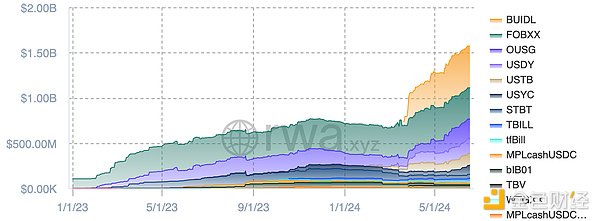
Market value trend of U.S. Treasury tokenized instruments, source:
rwa.xyz
Next, we will give examples of DeFi protocols that use the RWA model to provide returns to users. 5.1. Goldfinch Goldfinch is a lending protocol that has been pioneering the integration of DeFi and traditional financial products since July 2020. Based on its proprietary credit scoring system, the protocol provides unsecured cryptocurrency loans to real businesses around the world. These borrowers are mainly located in developing countries such as Asia, Africa and South America, with a total of approximately US$76 million in loaned and operating funds. Goldfinch has two different loan pools.
Junior Pool: It is established after the borrower applies for a loan and passes the review. Verified entities such as professional investment institutions and credit analysts deposit funds in the pool to lend to these borrowers. In the event of a default, the funds of the junior loan pool will be used first to cover the losses.
After completing the KYC process, users can deposit $USDC into the premium lending pool to obtain a share of the profits generated by Goldfinch through credit-collateralized lending, and at the same time obtain $FIDU tokens as proof of providing liquidity. When users want to exit, they can only deposit $FIDU and get $USDC back if there are idle funds in the premium lending pool. If there are no idle funds in the premium lending pool, users can still sell $FIDU on DEX to achieve the same effect. Conversely, users can also buy $FIDU tokens on DEX and obtain the profits generated by Goldfinch without KYC.
In the early days of its launch, Goldfinch distributed its governance token $GFI through liquidity mining, raising a large amount of liquidity. Even after the end of liquidity mining activities and the market downturn after the Luna-Terra incident, Goldfinch was still able to obtain stable net income from external sources, providing liquidity providers with a stable expected interest rate of about 8%.
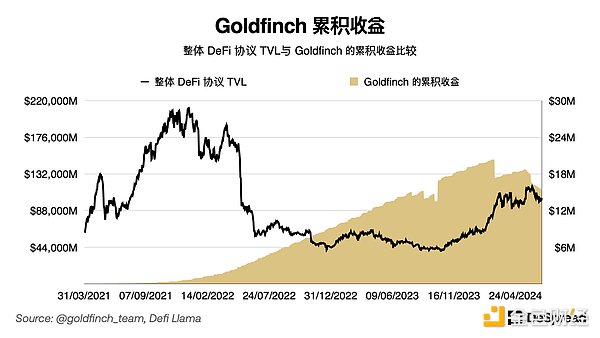
However, from August 2023 to date, Goldfinch has defaulted three times, exposing problems such as poor credit assessment and lack of the latest loan information, and the sustainability of the protocol has been questioned. In response, liquidity providers began selling their $FIDU tokens to the market, and given the revenue the protocol is able to generate, the price of $FIDU should rise, but as of June 2024, the value of $FIDU currently remains at $0.6, down from $1.
MakerDAO is an earlier Collateralized Debt Position (CDP) protocol in the Ethereum DeFi ecosystem, which aims to issue and provide users with stablecoins with collateralized stable value to cope with the volatile cryptocurrency market.
Users can pledge virtual assets such as Ethereum to MakerDAO as collateral and receive $DAI in return. MakerDAO maintains a stable reserve by continuously monitoring the value fluctuations of the collateral assets to measure the collateral ratio and liquidating the collateral assets when the collateral ratio falls below a certain level.
MakerDAO has two main revenue models.
Stability Fee: A fee paid by users who deposit collateral and issue and lend $DAI.
MakerDAO has a mechanism to incentivize $DAI holders, paying these fees as interest to users who deposit $DAI into the MakerDAO deposit system "DSR Contract", and using any remaining capital to purchase and burn MakerDAO's governance token $MKR to incentivize $MKR holders.
In May 2022, MakerDAO co-founder Rune Christensen proposed the "Endgame" plan, expressing the true decentralization of MakerDAO governance and operations and the long-term vision for the stability of DAI.
For further reading on "Endgame", please refer to the Endgame series published by DeSpread.
As mentioned in Endgame, one of the key challenges to ensure the stability of $DAI is to diversify the collateral assets currently dominated by $ETH, and MakerDAO has released a plan to introduce RWA as a collateral asset to achieve the following advantages.
RWA has price volatility characteristics different from crypto assets, which can achieve portfolio diversification.
After the Endgame proposal was passed, MakerDAO's relationship diagram is as follows.
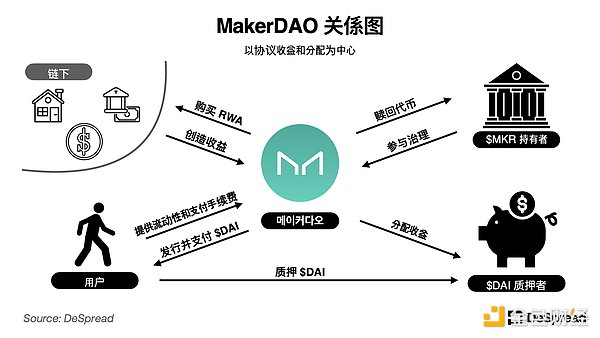
After the Endgame proposal was passed, MakerDAO diversified its portfolio by introducing various forms of RWA, including short-term U.S. Treasury bonds, real estate-backed loans, tokenized real estate, and credit-backed assets. Since the income from RWA is determined by external factors such as Treasury bond interest rates and off-chain lending rates, MakerDAO has reduced the impact of cryptocurrency market fluctuations through the integration of RWA, while obtaining a source of stable returns.
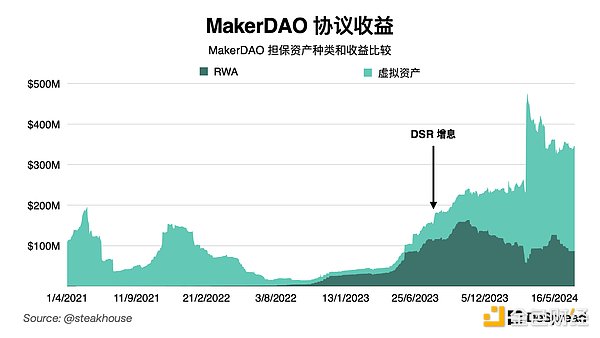
It is also because of this that in 2023, despite the bear market in the entire DeFi ecosystem, MakerDAO's RWA collateral assets were able to continue to generate stable returns, accounting for 70% of the protocol's total revenue. Based on these returns, MakerDAO was able to increase the interest rate of DSR from 1% and maintain it at 5%, effectively supporting the demand for $DAI.
In this way, MakerDAO started with a protocol for issuing stablecoins secured by on-chain assets, and through engagement with real-world finance, it has diversified its revenue sources and strengthened its connection with the real economy. This ensures the sustainability and long-term growth of the protocol, making MakerDAO the leading RWA protocol and pointing a new direction for the integration of traditional finance and DeFi.
In the fourth quarter of 2023, due to the expectation that the Bitcoin spot ETF will be approved soon, external liquidity began to flow into the market after nearly two years of stagnation. This prompted the DeFi ecosystem to break away from the traditional passive management structure and use the inflow of liquidity and its own token incentive mechanism to provide higher interest rates to introduce new liquidity.
However, unlike early projects, these protocols did not conduct the popular liquidity mining in the early stage. Instead, they adopted the model of airdropping based on points to increase the interval between the initial period of attracting liquidity and airdropping, so that the team can better manage the circulation of their own tokens.
Some protocols also adopted the "Restaking" model to quickly attract huge liquidity, and used the tokens that had been pledged to other protocols as pledged assets again to stack risks and generate additional income.
Although the cryptocurrency market has recovered after the Luna-Terra crisis, due to the high threshold for entering the on-chain environment, most of the market liquidity and user traffic are still concentrated on CEX, rather than DeFi protocols.
In particular, CEX provides users with a relatively familiar and simple trading environment, which has caused the trading volume of on-chain perpetual contract exchanges to drop to about 1/100 of CEX futures trading volume. This environment has led to the rise of the Basis Trading model protocol that uses CEX's trading volume and traffic to create additional income.

Comparison of futures trading volume between CEX and DEX, Source:
The Block
The basis trading model uses the assets deposited by users to create positions by capturing the price difference between spot, futures or futures of the same asset on CEX to generate income, which is distributed to liquidity providers. Compared with the RWA model that generates revenue directly from traditional finance, the advantage of these models is that they are less regulated, so they can build protocol structures more freely and adopt more active market strategies.
In the past, virtual asset custodians such as Celsius and BlockFi also used the leverage of liquidity providers to deposit assets on CEX to create and distribute income, but due to opaque fund management and over-leveraged investments, Celsius went bankrupt after the market crash in 2022, and the model of custodians managing deposited assets lost credibility in the market and gradually disappeared.
Therefore, the protocols of the basis trading model that have emerged in recent years are all striving to make the operation of the protocol more transparent than traditional custodians, and set up various devices to supplement their credibility and stability.
Next, we will explore some protocols that use basis trading to provide users with returns.
Ethena is a protocol that issues a synthetic asset $USDe worth $1. Ethena uses CEX futures to hedge its collateral assets to ensure that the collateral ratio does not change with the value fluctuations of the collateral assets to maintain a Delta Neutral state. The protocol can issue US dollars equivalent to the collateral assets and is not affected by market fluctuations.
The assets deposited by users on Ethena are distributed in the form of $BTC, $ETH, interest-earning Ethereum LST tokens, and $USDT through over-the-counter settlement (OES) providers. Ethena then hedges by opening a short position on CEX equivalent to its $BTC and $ETH spot collateral assets to maintain a Delta neutral state for the assets held.

Ethena pledge asset ratio, source: Ethena
In the process of mortgaging USDe, Ethena can obtain two kinds of returns.
LST Interest: The interest generated from Ethereum verification rewards is maintained at an annual interest rate of more than 3%, and will increase with the increase in Ethereum ecosystem activities. This income can bring an annual return of approximately 0.4% to the total spot collateral assets.
Contract Funding Fee: The fee paid by users holding overheated positions to users holding opposite positions to bridge the gap between spot and futures prices on CEX (considering that long positions are uncapped and at a disadvantage compared to short positions, long users pay short users 0.01% every 8 hours as the basic contract funding rate). Currently, Ethereum futures short positions can earn 8% per year on open positions.
In addition to distributing the income generated by basis trading to $USDe holders, Ethena is also conducting a second airdrop of the governance token $ENA. In the process, Ethena distributes more points to holders than $USDe stakers to ensure that the protocol income is concentrated among a small number of stakers, making the interest rate for $USDe staked equivalent to 17% on June 20, 2024.
In addition, by announcing that more airdrops will be provided to $ENA stakers in the future, the selling pressure of $ENA is reduced and the initial liquidity of $ENA is attracted. As a result of these efforts, about $3.6 billion of $USDe has been issued to date, becoming the fastest stablecoin to reach a market value of $3 billion.
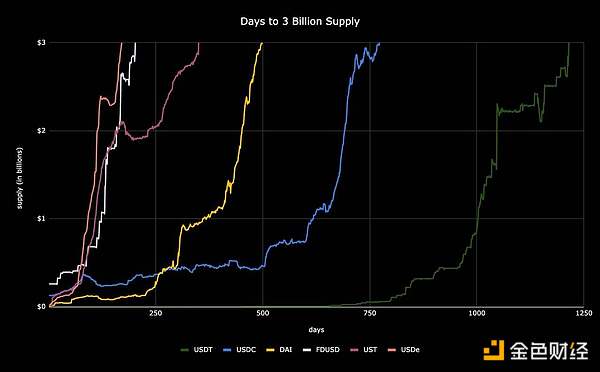
The time it took for stablecoins to reach a market value of $3 billion, source: @leptokurtic_’s Twitter
Although Ethena It has achieved some success in quickly obtaining initial liquidity, but from a sustainable development perspective, it faces the following limitations.
Once the points activity ends, the demand for Ethena will decrease, resulting in a decrease in staking income.
The interest rate from the contract funding rate is variable and fluctuates with market conditions, especially when short positions increase in a bear market, there is a possibility of a decline.
Currently, the only reason to stake $ENA to Ethena is to earn extra $ENA, so $ENA may face significant selling pressure after the airdrop event.
To prevent $USDe and $ENA from losing liquidity, a partnership with the staking protocol Symbiotic was recently announced as a first step to increase the utility of both tokens by staking $USDe and $ENA on a PoS intermediary protocol that requires a security budget to earn additional income.
The following is Ethena's current relationship.
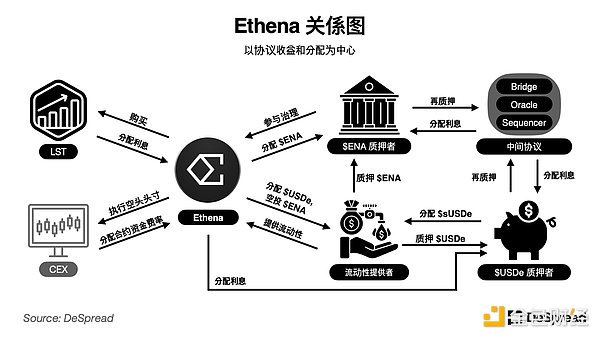
Ethena is improving the transparency of existing asset custodians, mainly by disclosing the wallet addresses of OES providers and publishing reports on positions and asset holdings to prove the stability of assets. Not only that, Ethena also plans to use ZK technology to conduct real-time verification of all assets held by OES providers to further improve transparency.
BounceBit is a PoS-based L1 network that generates additional income by running Delta-neutral positions on centralized exchanges (CEX) using user-bridged assets. Starting June 2024, users can bridge two assets from other networks to BounceBit, including $BTCB and $USDT.
The assets bridged by users will be traded on CEX through asset management entities, and BounceBit will pay users with Liquid Custody Tokens $BBTC and $BBUSD available on the network at a 1:1 ratio as proof of pledge. Users can use the received $BBTC to stake with BounceBit's native token $BB to assist in network verification, and the staking users will receive liquidity tokens $stBBTC and $stBB proving the pledge, as well as interest paid in $BB.
Users can also earn additional income by re-staking $stBBTC on Shared Security Clients (SSC) that cooperate with BounceBit, or deposit it into the Premium Yield Generation Vault to obtain the income generated by BounceBit basis trading. Currently, the function of re-staking to SSC is not yet open, and additional income can only be obtained through the Premium Yield Generation Vault.
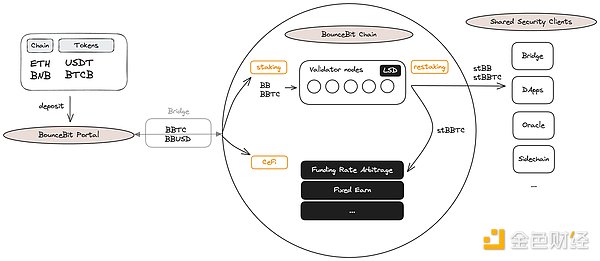
BounceBit user capital flow diagram, source: BounceBit Docs
When users deposit assets into Premium Yield Generation Vault, they can choose which of the five asset management institutions that cooperate with BounceBit to collect profits. When these asset managers use BounceBit’s bridged assets on CEX, they use the MirrorX feature to execute transactions without actually depositing the assets on CEX. BounceBit also publishes asset status reports regularly to ensure the stability and transparency of bridged assets.
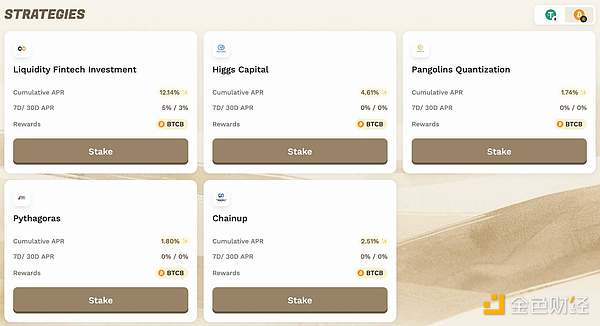
BounceBit Premium Yield Generation Vault partner, Source: BounceBit
Currently, BounceBit's highest yield is 16%, which includes 4% network staking interest and 12% Premium Yield Generation Vault's yield, which is quite high for a commodity with BTC as the underlying asset. However, the sustainability of these yields remains to be seen, as staking interest will fluctuate with the price fluctuations of $BB, and the yield of the underlying transaction also depends on market conditions.
Compared to the DeFi ecosystem, protocols that adopt this emerging basis trading model use CEX trading volume and liquidity to generate stable returns, which constitutes a key part of the stability of protocol returns. Not only that, it can also be seen that these protocols also provide additional returns to users through active DeFi protocol strategies such as liquidity of staked assets (to facilitate use on other protocols) and issuance of their own tokens.
In this article, we explored the evolution of yield models in the DeFi ecosystem, and also learned about the protocols that maintain yield and liquidity by adopting elements such as RWA and basis trading. Considering that both RWA and basis trading models are still in the early stages of adoption, we can expect the influence of this model in the DeFi ecosystem to grow.
Although RWA and basis trading models borrow elements of centralization, their common goal is to bring assets and liquidity outside the DeFi ecosystem into DeFi protocols. In the future, the development of on-ramp and off-ramp solutions to a certain extent and changes centered on cross-chain interoperability will replace these centralized factors, improve the convenience of users in the DeFi ecosystem, and continue to lead the innovation of new DeFi protocols based on the increase in blockchain usage.
Although these centralized elements occupy a major part of the current DeFi ecosystem, which contradicts Satoshi Nakamoto's creation of Bitcoin to solve traditional financial problems, considering that the modern financial system is built on the basis of capital efficiency, it is natural to explain that DeFi as a new type of finance will undergo this transformation.
As DeFi moves towards centralization, we will continue to see the emergence of protocols that attach more importance to the principle of decentralization, such as the stablecoin protocol Reflexer that is not pegged to the US dollar and has an independent price formation system. These protocols will form a complementary relationship with those that introduce centralized elements, creating a balance in the DeFi ecosystem.
We can look forward to a more mature and efficient financial system, and we can also wait and see how blockchain finance represented by "DeFi" will change and be defined in the future.
Since the beginning of 2024, the total value locked in liquid re-staking tokens has risen by more than 8,300%.
 JinseFinance
JinseFinanceWhat does it mean that the total network computing power has not decreased after the halving? A large number of machines should have been eliminated and shut down, but this did not happen.
 JinseFinance
JinseFinanceNew liquidity re-hypothecation platforms like Puffer and Ether.Fi have attracted billions of dollars in deposits, but they have also sparked a “points” frenzy that comes with risks.
 JinseFinance
JinseFinanceBerachain aims to provide high security, decentralization and scalability while leveraging the power of meme culture and community to create a vibrant ecosystem.
 JinseFinance
JinseFinance JinseFinance
JinseFinanceDetailed Post-Mortem and Next Steps
 Others
OthersA simple guidance manual for crypto newcomers to get onto DeFi as quickly as possible. In this episode, I will explain liquidity and pooling as layman-friendly as possible.
 Nell
Nell Beincrypto
Beincrypto“This quarter, we saw significant improvements in the energy efficiency and sustainability of Bitcoin mining, a trend that will continue,” said MicroStrategy founder and CEO Michael Saylor.
 Cointelegraph
CointelegraphVCs have become critical in providing liquidity to the Solana ecosystem.
 Cointelegraph
Cointelegraph